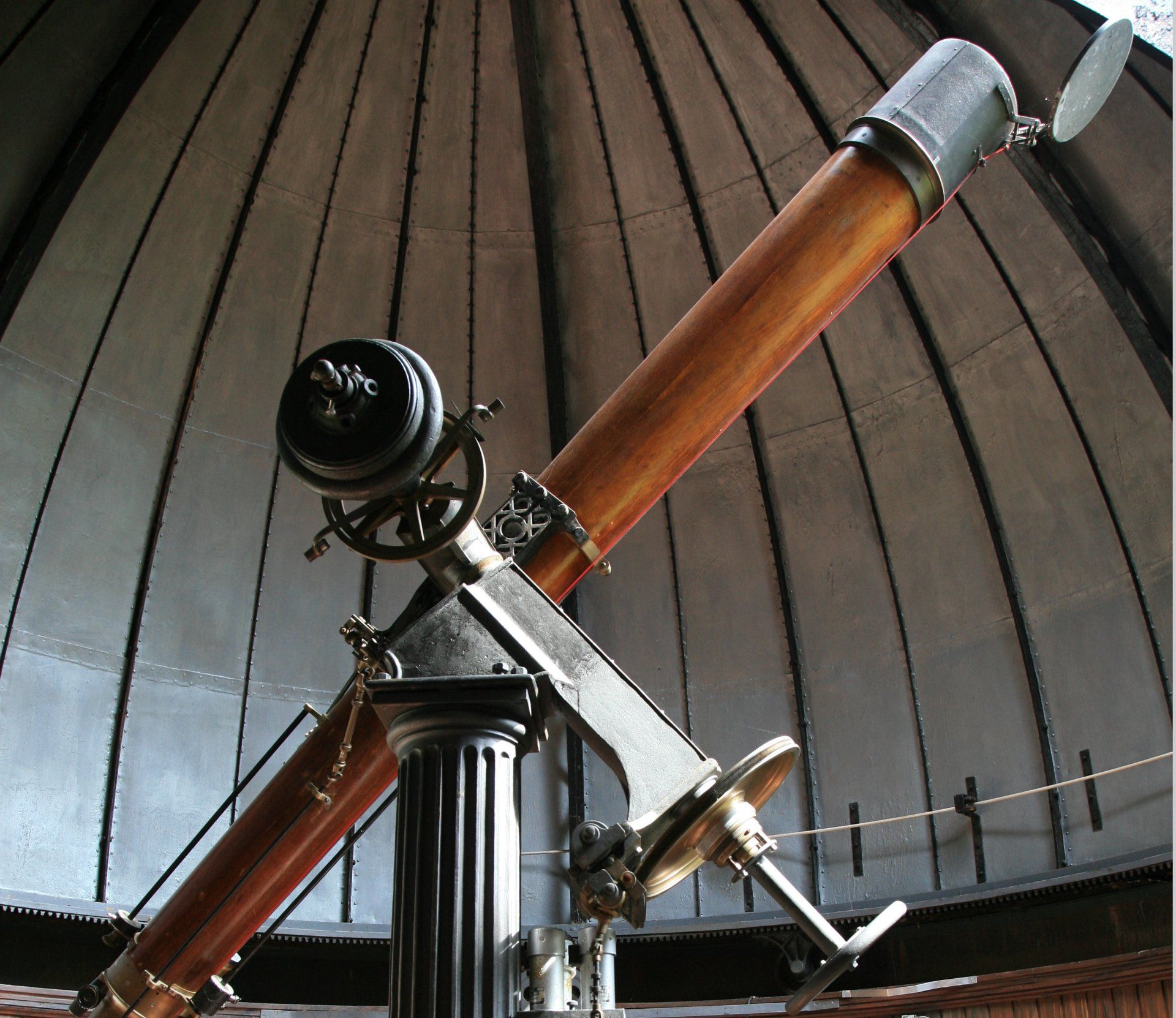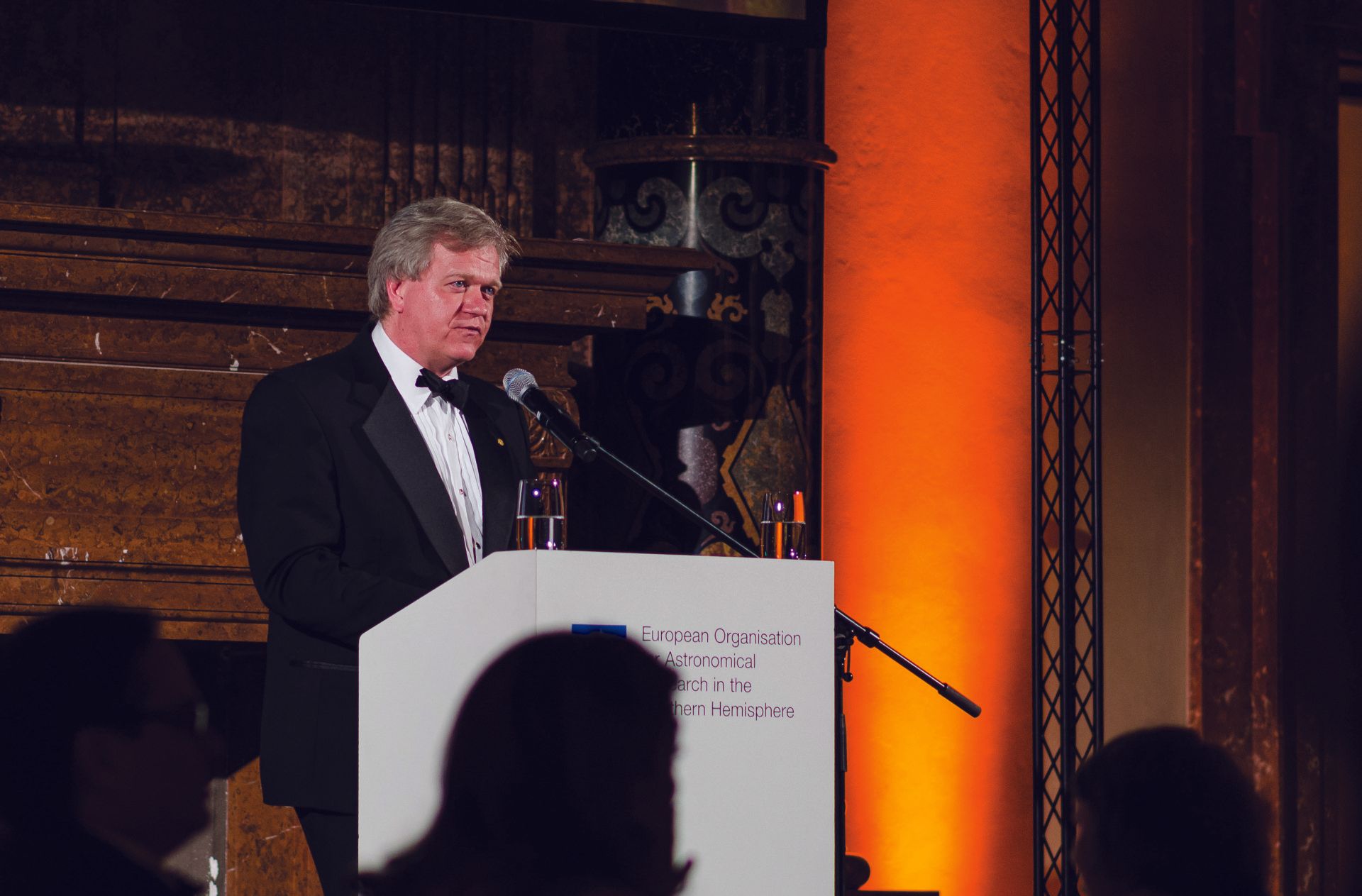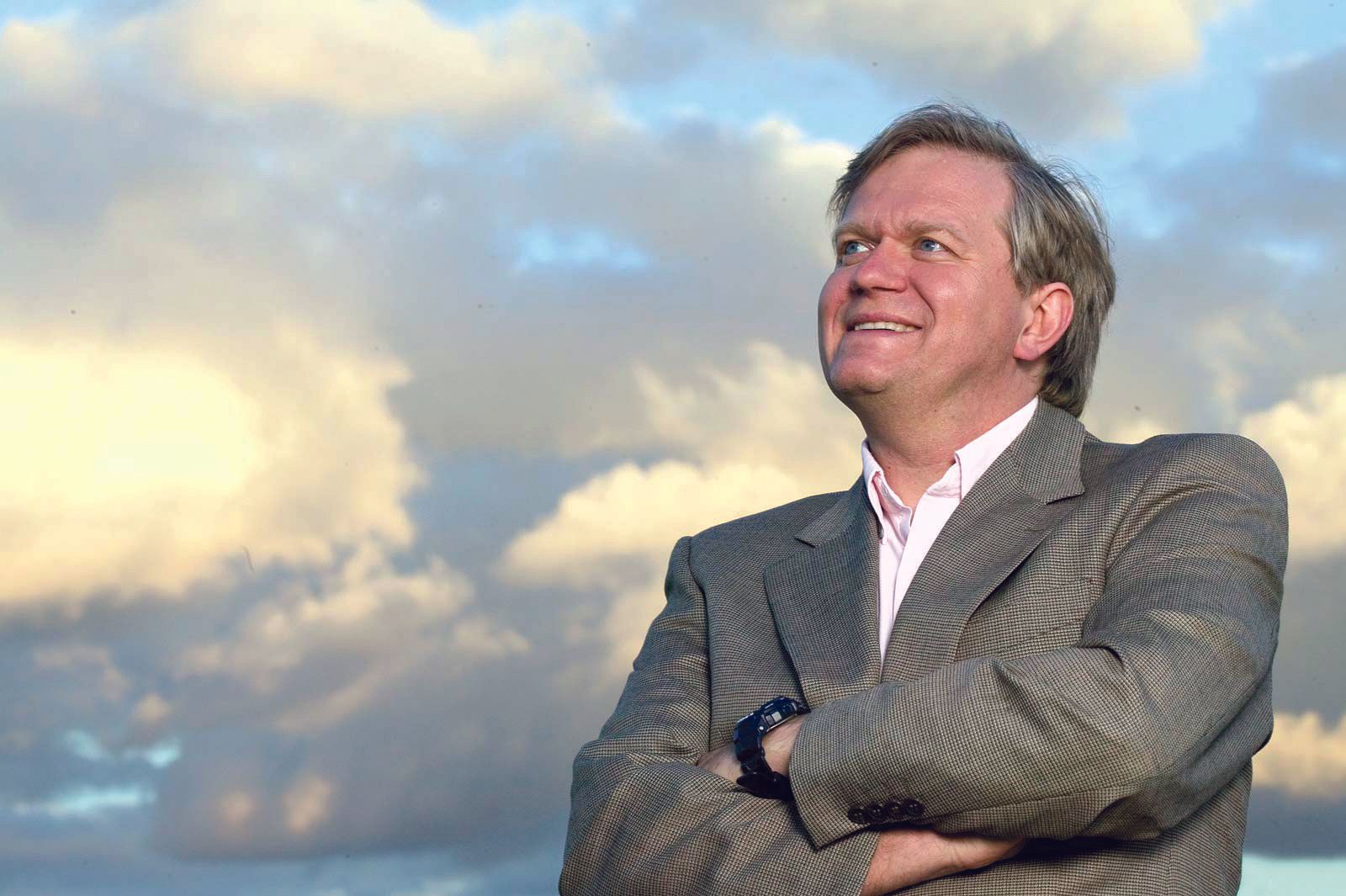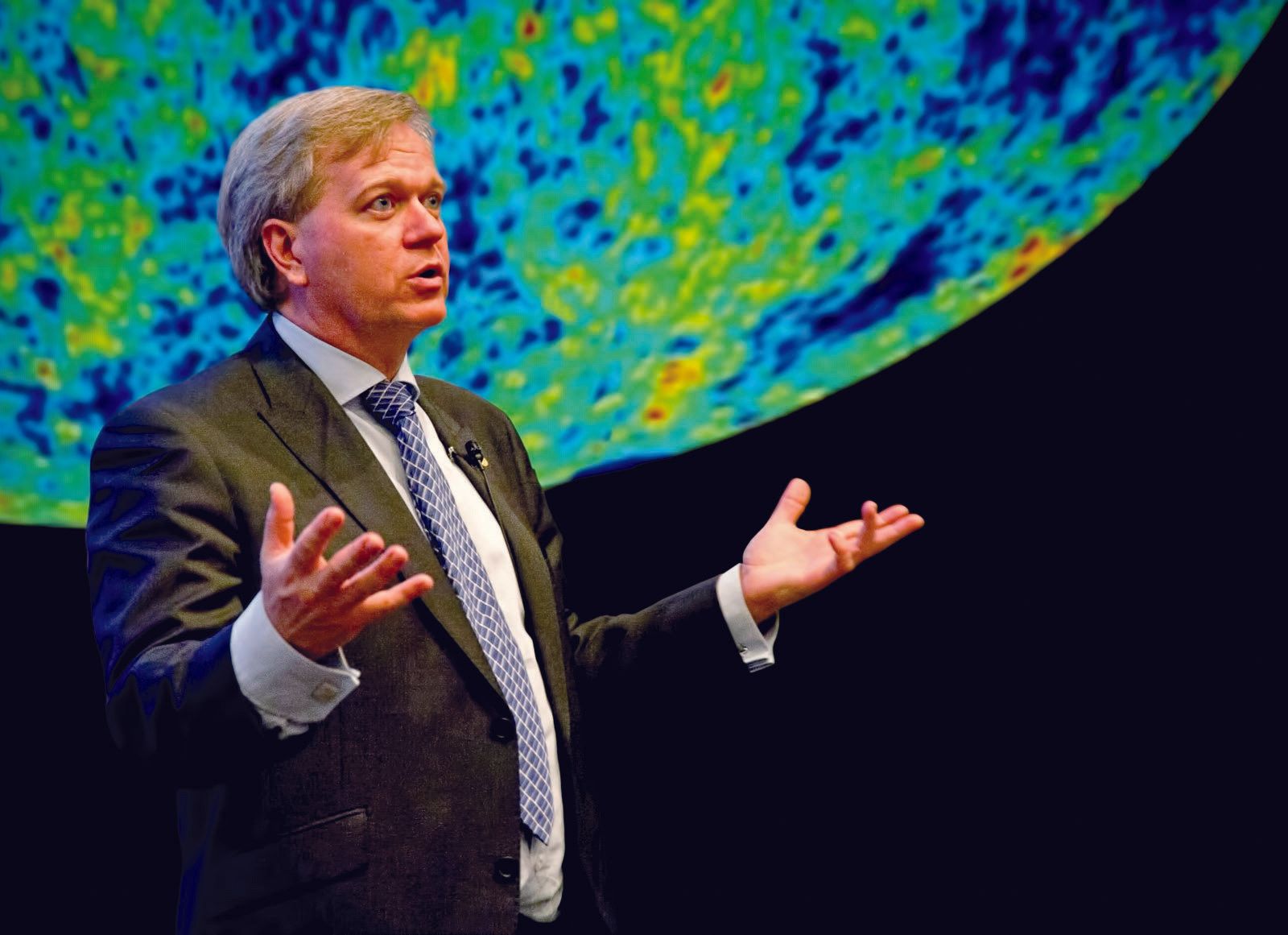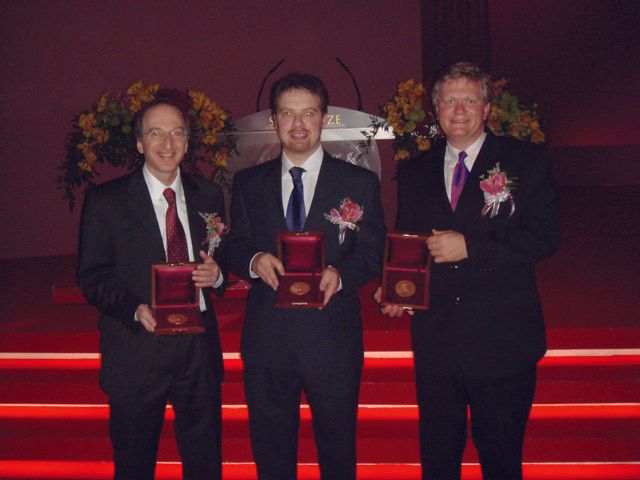Discovering the Death of the UniverseBy Tim Mendham
Discovering the Death of the Universe
By Tim Mendham
Brian Paul Schmidt
Nobel Prize in Physics 2011
Shared with Adam Riess and Saul Perlmutter
Dark forces and exploding stars measure distance and time in space to reveal a universe moving at a profoundly unexpected pace.
Dark forces and exploding stars measure distance and time in space to reveal a universe moving at a profoundly unexpected pace.
The Universe is expanding, and it is doing so at an accelerating rate. Gravity can no longer slow it down, let alone bring it together. Eventually, all but the nearest stars will disappear from our view, and the Universe will cool and turn to ice.
And we know this encouraging scenario thanks to the work of the winners of the Nobel Prize in Physics for 2011.
In what has been described as a “milestone for cosmology”, the work of astronomers on opposite sides of the world, including Australian Brian Schmidt, succeeded in overturning what has been the accepted (or at least hoped for) picture of the Universe as a gradual decelaration after the initial impetus of the Big Bang, followed by a pulling together of the cosmos once more into a small body of matter. Just like a rubber band, stretched by initial forces and then pulling back to its original shape.
Except the Nobel Laureates have shown that the rubber band could no longer contain the tension, and the band has gone on expanding, faster and faster, until…
The Nobel Prize is shared between Brian Schmidt of Australia, his American colleague Adam Riess who has worked with him, and American scientist Saul Perlmutter from the University of California, Berkeley.
Two teams of astronomers have been competing with each other to find the evidence for the accelerating Universe. One, lead by Perlmuttter of the Supernova Cosmology Project, began work in 1988. The other, headed by Chmidt and assisted by Riess, set up their operations at the Australian National University (ANU) in 1994.
The competition paid off
By the 1998, the two research teams were ready to present their findings, with some trepidation.
“When Adam and I were talking about the first results that he was coming out with,” Schmidt says, “and we could see the results and the data, I have to admit that I just figured that a mistake had been made. But that mistake never really went away. And so, after about six weeks, I think the surprise of what was in the data had worn off, but then I think we had to face the realities that we were going to have to tell the world about it. I wasn’t so convinced that they would be terribly kind in response to our findings, as it just seemed crazy.”
Searching for stars
The goal of Schmidt, his team and his competitors, was to map the Universe by finding the most distant supernovae – star explosions in space. By establishing the distance to the supernovae and the speed at which they are moving away from us, the scientists hoped to reveal our cosmic fate. They expected to find signs that the expansion of the Universe was slowing down, which would lead to equilibrium between fire and ice. They found the opposite: the expansion was accelerating.
Only a hundred years ago, the Universe was considered to be a calm and peaceful place, no larger than our own galaxy, the Milky Way. The cosmological clock was ticking reliably and steadily and the Universe was eternal. That picture was about to change. At the beginning of the 20th century the American astronomer Henrietta Swan Leavitt found a way of measuring distances to faraway stars. At the time, women astronomers were denied access to the large telescopes, and they were frequently employed for the cumbersome task of analysing photographic plates. Leavitt studied thousands of pulsating stars, called Cepheids, and found that the brighter ones had longer pulses. Using this information, she could calculate the intrinsic brightness of Cepheids. If the distance of just one of the Cepheid stars is known, the distances to others can be established- the dimmer its light, the farther away the star. In the 1920s, astronomers were able to show that almost all galaxies are moving away from us. They were studying the “redshift” that occurs when a source of light is receding from us. The light’s wavelength gets stretched, and the longer the wave, the redder its colour.
The conclusion was that the galaxies are rushing away from us and each other, and the farther away they are, the faster they move- this is known as Hubble’s law. The Universe is growing. What was observed in space had already been suggested by theoretical calculations. In 1915, Albert Einstein published his General Theory of Relativity, which has been the foundation of our understanding of the Universe ever since. The theory describes a Universe that has to either shrink or expand. This conclusion was reached about a decade before the discovery of the ever-fleeing galaxies. Not even Einstein could reconcile the fact that the Universe was not static, so he proposed a “cosmological constant”, a modification of his original theory of general relativity to achieve a stationary universe. Later, after the redshift observations, Einstein would consider the insertion of the cosmological constant a big mistake. However, with the observations made in the late 1990s by the teams awarded this year’s Nobel Prize, there has been renewed interest in Einstein’s “constant”. The task of proving Einstein right or wrong is a major challenge, especially in an area which has just undergone a massive change of view. “We’re trying to test the model [of the accelerating Universe] as hard as we can,” Schmidt says. “We’re trying to push the model to see if we can break it, to see whether or not Einstein’s cosmological constant -that’s the explanation of the acceleration- whether or not we can show that that’s wrong. At this point we haven’t been able to do that, but if we were able to show that it was wrong, then I think we would get some insight into what was going on. But if it really does look like Einstein’s cosmological constant [is correct], then I think we really need to have some brilliant mind, an Einstein-like figure, come along, and from a theoretical point-of-view, shine some light on what’s going on.” In their observations, the two teams expected to measure the cosmic deceleration, or how the expansion of the Universe is slowing. Their method was, in principle, the same as the one used by astronomers more than six decades earlier: to locate distant stars and to measure how they move. But at the distances that astronomers need to see, billions of light years away, the previous yardsticks, the Cepheids, are no longer visible. The cosmic yardstick needed to be extended.
New measure of brightness
Supernovae - star explosions - became the new standard measure of brightness. More sophisticated telescopes on the ground and in space, as well as more powerful computers, opened the possibility in the 1990s to add more pieces to the cosmological puzzle. Crucial were light-sensitive digital imaging sensors - charged-coupled devices or CCDs. The invention of these devices gave Willard Boyle and George Smith the Nobel Prize in Physics in 2009. The newest tool in the astronomer’s toolbox is a special kind of star explosion, the type Ia supernova. During a few weeks, a single such supernova can emit as much light as an entire galaxy. This type of supernova is the explosion of an extremely compact old star that is as heavy as the sun but as small as the earth - a white dwarf. The explosion is the final step in the white dwarf’s life cycle. White dwarfs form when a star has no more energy at its core, as all hydrogen and helium have been burned in nuclear reactions. Only carbon and oxygen remain. Our sun will eventually follow the same path. A far more exciting end awaits a white dwarf that is part of a binary star system, which is fairly common. In this case, the white dwarf’s strong gravity robs the companion star of its gas. When the white dwarf has grown to 1.4 solar masses, it no longer manages to hold together. When this happens, the interior of the dwarf becomes sufficiently hot for runaway fusion reactions to start, and the star gets ripped apart in seconds. The nuclear fusion products emit strong radiation that increases rapidly during the first weeks after the explosion, only to decrease over the following months, so there is a rush to find supernovae - their violent explosions are brief. Across the visible Universe, about ten type-la supernovae occur every minute. But in a typical single galaxy, only one or two supernova explosions occur in a thousand years. So the two competing teams knew they had to comb the heavens for distant supernovae. The trick was to compare two images of the same small piece of the sky, corresponding to a thumbnail at arm’s length. The first image has to be taken just after the new moon and the second three weeks later, before the moonlight swamps out starlight. Then the two images can be compared in the hope of discovering a small dot of light - a pixel among others in the CCD image - that could be a sign of a supernova in a galaxy far away. Only supernovae farther than a third of the way across the visible Universe were used, in order to eliminate local distortions. Chasing supernovae challenged not only the limits of science and technology but also those of logistics. First, the right kind of supernova had to be found. Second, its redshift and brightness had to be measured. The light curve had to be analysed over time in order to be able to compare it to other supernovae of the same type at known distances. This required a network of scientists that could decide quickly whether a particular star was a worthy candidate for observation. They needed to be able to switch between telescopes and have observation time at a telescope granted without delay, a procedure that usually takes months. They needed to act quickly because a supernova fades quickly. At times, the two competing research teams discreetly crossed each other’s paths.
The potential pitfalls had been numerous, and the scientists actually were reassured by the fact that they had reached the same amazing results: all in all, they found some 50 distant supernovae whose light seemed weaker than expected. This was contrary to what they had envisioned. If cosmic expansion had been losing speed, the supernovae should appear brighter. However, the supernovae were fading as they were carried faster and faster away, embedded in their galaxies. The surprising conclusion was that the expansion of the Universe is not slowing down - quite to the contrary, it is accelerating.
Going Against Expectations
So what is it that is speeding up the Universe? It is something called dark energy and is a challenge for physics, a riddle that no-one has managed to solve. Several ideas have been proposed. The simplest is to reintroduce Einstein’s cosmological constant. At the time, Einstein inserted the cosmological constant as an anti-gravitational force to counter the gravitational force of matter and thus create a static universe. Today, the cosmological constant instead appears to make the expansion of the Universe accelerate. The cosmological constant is, of course, constant, and as such does not change over time. So dark energy becomes dominant when matter, and thus its gravity, is diluted due to the expansion of the Universe over billions of years.
According to scientists, that would account for why the cosmological constant entered the scene so late in the history of the Universe, only five to six billion years ago. At about that time, the gravitational force of matter had weakened enough in relation to the cosmological constant. Until then, the expansion of the Universe had been decelerating. The simplest estimation for the amount of dark energy does not correspond at all to the amount that has been measured in space. This constitutes a still unexplained gap between theory and observation. It may be that the dark energy is not constant after all. But, as Schmidt says, “I think that the idea that there was some other big thing in the universe, other than things that have normal gravity, meant that a lot of the problems that existed in cosmology back in 1998 were suddenly solved. So there were a lot of people, and especially theorists, who wanted the universe to be geometrically flat, which means it had to have a lot of stuff in it that we just didn’t know was there. And this stuff solved that problem. It gave the extra matter in a universe that needed to be flat.” Whatever dark energy is, it seems to be here to stay. It fits very well in the cosmological puzzle that physicists and astronomers have been working on for a long time. According to current consensus, about three quarters of the Universe consists of dark energy. The regular matter, the stuff that galaxies, stars, humans and flowers are made of, is only 5 per cent of the Universe. The remaining 20 per cent is called dark matter and is so far hidden from us. Like dark energy, dark matter is invisible. So we know both only by their effects - one is pushing, the other one is pulling. “But the model of dark energy, dark matter, normal atoms, really explains in exquisite detail the observations we make of the Universe,” Schmidt says. “So, on one side we have a very precise model of the universe now, that we can test, and every time we test it we keep on getting the same answers. But the fundamental understanding of ‘What is this dark matter?’ and ‘What is this dark energy?’ remains. And so I think that’s the more fundamental question.” Therefore, the findings of the 2011 Nobel Laureates in Physics have helped to unveil a universe that is up to 95 per cent unknown to science. As Schmidt says, “It seems that cosmologists are comfortable with a large degree of uncertainty.”
Towards the Award
And while there is uncertainty in all aspects of life, Schmidt has had a history of determined and considered action. Born in 1967 in Montana, United States, and moving with his family to Alaska, he set in train a distinguished career, both abroad and in Australia, which would lead him to the Nobel Prize. As a youngster, he showed an interest in meteorology, and for a short time after graduating from high school he worked at the US National Weather Service in Anchorage. That was not quite what he was after - it was less scientific and not as exciting as he had hoped it would be. Instead, he moved into the field of astronomy, something that had previously only been a minor interest. He earned his BS (Physics) and BS (Astronomy) from the University of Arizona, where he was named Most Outstanding Student in Physics in 1989. He initially taught astronomy at Arizona and then moved on to complete his Masters and PhD at Harvard. At that university he was awarded the Danforth Award for excellence in teaching, and his time there included a stint as a postdoctoral fellow ‘at the Harvard-Smithsonian Center for Astrophysics. It was at Harvard that he met his wife, Jennifer M Gordon, an Australian who was a PhD student in economics. In 1994, they moved to Australia. He now holds dual citizenship for the US and Australia. Picking up his teaching career at the Australian National University (ANU) in Canberra, he launched himself into the study of supernovae that led to the Physics award. In the same year as he arrived in Australia, he formed the High-z Supernova Search Team, a group of 20 astronomers on five continents who used distant exploding stars to trace the expansion of the Universe back in time. The research by this team was named the 1998 Science Magazine’s Breakthrough of the Year. But Schmidt has additional interests of a lot more earthy nature than the cosmos. He owns Maipenrai, a small vineyard and winery in the Canberra region. This is dedicated to making “fine Pinot Noir without compromise”. The wine is sourced from Maipenrai’s close-planted 1.1 hectare vineyard atop the Yass River Valley. Situated at an altitude of 760 metres, the vineyard’s rocky soil and cold climate “make our six clones of Pinot Noir struggle, but provide an intensity to our wines that can only be achieved in such harsh conditions”. He also prides himself on his cooking. In fact, it was while preparing the evening’s meal that he had the call to let him know he had won the Nobel Prize -a meal that he happily admits he never got to eat, such was the immediate rush of congratulations and media interest.
So what was it like to win the award?
Just after the announcement, he told Nobel Media: “I feel like when my first child was born. I’m kind of weak in the knees and a little, you know ... hard to describe - almost speechless at this point. It’s pretty unexpected and so very big news, and I guess I’m still just trying to get my head around it.” He says he had no idea that the award was coming his way, even though he was in Stockholm in August, only weeks before the announcement. “I have several friends who are members of the Swedish Academy and had no inkling whatsoever.” Back at the observatory, Schmidt says that “astronomy is really going through a heyday right now. That is, it’s very well supported compared to what it was 30 or 40 years ago. But I think one thing to remind ourselves is that great ideas don’t need billions of dollars, they need moderate support, and you need to have a lot of people with moderate support to get the good ideas. There are also needs for great big experiments and those are expensive, but they tend not to be so imaginative. They’re sort of the brute force way of solving problems. And so, I’m a very strong believer that you want to try both things, but you want to make sure you keep a bunch of smaller groups with innovative ideas, at the same time as maybe a couple of brute force big experiments.” So will the award encourage others to enter the astronomical fray? “I certainly hope so. I hope that it will remind people of how exciting astronomy is, and how trying to understand the universe is something that really helps us understand our place in the universe. And it’s certainly my hope that children in Australia, but also around the world, will go through and say ‘Ah, I’d kind of like to figure out how to do that myself’.” But even with the latest technology at their disposal, enabling that next generation of enthusiasts to do better and better experiments, the technology is still the tool. It is those “great ideas” that keep the experimenters, observers and theorists moving forward. “Astronomy is not like a physics lab. You can’t design an experiment. You need to go through and look up into the heavens, and sort of figure out what the cosmos has given you, and make an experiment out of that. So it’s a very different process. And there’s always the chance of having a really good idea of how to put together things in space to do the experiment that you want to do.” And, occasionally, receive the accolade of the world’s foremost scientific award.
Vital statistics
Name: Brian Paul Schmidt
Born: Missoula, Montana, US
Birthdate: February 24 1967
School: Barlett High School, Anchorage, Alaska
University: University of Arizona, Harvard University
Married: Jennifer M Gordon in 1992
Children: Kieran G Schmidt (born 1994) and Adrian G Schmidt (born 1997)
Lives: Canberra, ACT, Australia
Awards and Accolades:
1989: Most Outstanding Student in Physics, The University of Arizona
1991: Danforth Award for excellence in teaching, Harvard University
1992-3: NASA Graduate Student Researchers Program Fellowship
1998: Research named the Science Magazine’s Breakthrough of the Year
1999: Finalist in UNSW Eureka Prize for Scientific Research
2000: Bok Prize for outstanding Astronomical Thesis, Harvard University
2000: The Australian Government’s Malcolm McIntosh Prize
2001: Oliphant Lecture, Australian Academy of Sciences
2001: The Australian Academy of Science Pawsey Medal
2004: Australian Academy of Science 50th Anniversary Lecture
2006: Shaw Prize (Astronomy – joint win with Riess and Perlmutte)
2007: Gruber Prize for Cosmology (joint with High-Z and SCP Teams)
2007: Niehls Bohr Lecture, Copenhagen
2008: Elected Fellow of the Australian Academy of Sciences
2008: Elected Fellow of the US National Academy of Sciences
2010: Peter Baume Award, ANU
2011: Nobel Prize in Physics
2013: Companion to the Order of Australia
2016: Vice-Chancellor, Australian National University
Why he was awarded the Nobel Prize:
The 2011 Nobel Prize in Physics was awarded to three astronomers: Brian Schmidt and Adam Riess of the High-z Supernova Search Team, ANU, and Saul Perlmutter of the Supernova Cosmology Project, Lawrence Berkeley National Laboratory and University of California.
In 1988, cosmology was shaken to its foundations as two research teams presented their finsings. Headed by Perlmutter, one of the teams had set to work in 1988. Schmidt headed another team, launched at the end of 1994, where Riess was to play a crucial role.
The research teams raced to map the Universe by locating the most distant supernovae. More sophisticated telescopes on the ground and in space, as well as more powerful computers and new digital imaging sensors, opened the possibility in the 1990s to add more pieces to the cosmological puzzle.
The teams used a particular kind of supernova, called type Ia supernova. It is an explosion of an old compact star that is as heavy as the sun but as small as Earth. A single such supernova can emit as much light as a whole galaxy. The two research teams found over 50 distant supernovae whose light was weaker than expected: this was a sign that the expansion of the Universe was accelerating. The potential pitfalls had been numerous, and the scientists found reassurance in the fact that both groups had reached the same astonishing conclusion.
For almost a century, the Universe has been known to be expanding as a consequence of the Big Bang about 14 billion years ago. The discovery that this expansion is accelerating was astounding. If the expansion will continue to speed up, the Universe will end in ice.
The expansion is thought to be driven by dark energy, but what that dark energy is remains an enigma, one of the greatest in physics today. What is known is that dark energy constitutes about three quarters of the Universe.
Therefore the findings of the 2011 Nobel Laureates in Physics have helped to unveil a universe that to a large extent is unknown to science.

